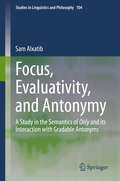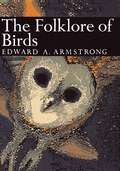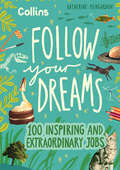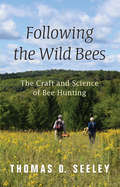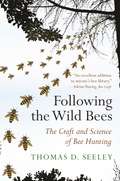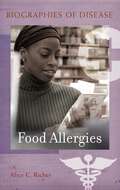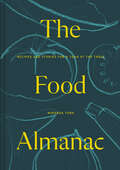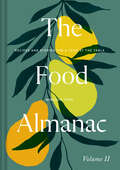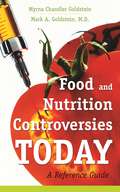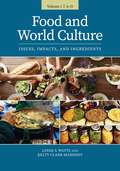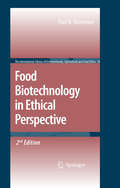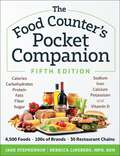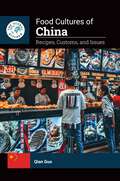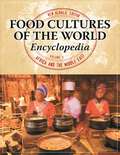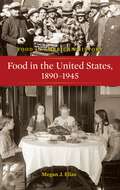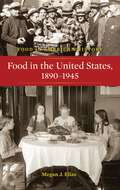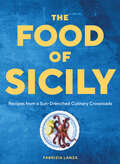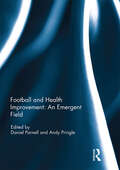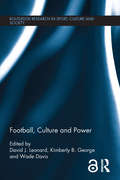- Table View
- List View
Focus, Evaluativity, and Antonymy: A Study in the Semantics of Only and its Interaction with Gradable Antonyms (Studies in Linguistics and Philosophy #104)
by Sam AlxatibThis book uncovers properties of focus association with 'only' by examining the interaction between the particle and bare (or “evaluative”) gradable terms. Its empirical building blocks are paradigms involving upward-scalar terms like 'few' and 'rarely', and their downward-scalar antonyms 'many' and 'frequently', an area that has not been studied previously in the literature. The empirical claim is that associations of the former type give rise to unexpected readings, and the proposed theoretical explanation draws on the properties of the latter type of association. In presenting the details, the book deconstructs the so-called scalar presupposition of 'only' and derives it from constraints against its vacuous use. This view is then combined with a semantics of the evaluative adjectives 'many' and 'few' to explain why the unavailable (but expected) meanings of the given constructions are unavailable. The attested (but unexpected) readings of 'only+few/rarely' associations are derived from independently motivated LFs in which the degree expressions are existentially closed. Finally, the book provides new findings, based on the core proposal, about 'only if' constructions, and about the interaction between 'only' and other upward-scalar modified numerals (comparatives, and 'at most'). The book thus provides new data and a new theoretical view of the semantic properties of 'only', and connects it to the semantics of gradable expressions.
The Folklore of Birds: An Enquiry Into The Origin & Distribution Of Some Magico-religious Traditions (Collins New Naturalist Library #39)
by Edward A. ArmstrongTracing the magico-religious beliefs surrounding birds as far back in time as is possible, to the cultures in which these beliefs arose. This edition is exclusive to newnaturalists.com
Follow Your Dreams: 100 Inspiring And Extraordinary Jobs
by Katherine Mengardon Collins KidsDiscover 100 inspiring and extraordinary jobs in this illustrated book for kids! Why not become a cat behaviourist? Or a rollercoaster engineer? How about a coral reef gardener?
Following the Wild Bees: The Craft and Science of Bee Hunting
by Thomas D. SeeleyFollowing the Wild Bees is a delightful foray into the pastime of bee hunting, an exhilarating outdoor activity that used to be practiced widely but which few people know about today. Thomas Seeley, a world authority on honey bees, vividly describes the history and science behind this lost pastime and how anyone can do it. Following the Wild Bees is both a unique meditation on the pleasures of the natural world and a guide to the ingenious methods that compose the craft of the bee hunter.Seeley explains how one finds a patch of flowers humming with honey bees, captures and sumptuously feeds the bees, and then releases and follows them, step-by-step in whatever direction they fly, back to their secret residence in a hollow tree, old building, or abandoned hive. The bee hunter's reward is a thrilling encounter with nature that challenges mind and body while also giving new insights into the remarkable behavior of honey bees living in the wild.Drawing on decades of experience as a bee hunter and bee biologist, Seeley weaves informative discussions of the biology of wild honey bees with colorful historical anecdotes, personal insights, and beautiful photos. Whether you're a bee enthusiast or just curious about the natural world, Following the Wild Bees is the ideal companion for newcomers to bee hunting and a rare treat for armchair naturalists.
Following the Wild Bees: The Craft and Science of Bee Hunting
by Thomas D. SeeleyFollowing the Wild Bees is a delightful foray into the pastime of bee hunting, an exhilarating outdoor activity that used to be practiced widely but which few people know about today. Thomas Seeley, a world authority on honey bees, vividly describes the history and science behind this lost pastime and how anyone can do it. Following the Wild Bees is both a unique meditation on the pleasures of the natural world and a guide to the ingenious methods that compose the craft of the bee hunter.Seeley explains how one finds a patch of flowers humming with honey bees, captures and sumptuously feeds the bees, and then releases and follows them, step-by-step in whatever direction they fly, back to their secret residence in a hollow tree, old building, or abandoned hive. The bee hunter's reward is a thrilling encounter with nature that challenges mind and body while also giving new insights into the remarkable behavior of honey bees living in the wild.Drawing on decades of experience as a bee hunter and bee biologist, Seeley weaves informative discussions of the biology of wild honey bees with colorful historical anecdotes, personal insights, and beautiful photos. Whether you're a bee enthusiast or just curious about the natural world, Following the Wild Bees is the ideal companion for newcomers to bee hunting and a rare treat for armchair naturalists.
Following the Wild Bees: The Craft and Science of Bee Hunting
by Thomas D. SeeleyA how-to book on an exhilarating outdoor activity and a unique meditation on the pleasures of the natural worldFollowing the Wild Bees is a delightful foray into the pastime of bee hunting, an exhilarating outdoor activity that used to be practiced widely but which few people know about today. Weaving informative discussions of bee biology with colorful anecdotes, personal insights, and beautiful photos, Thomas Seeley describes the history and science behind this lost pastime and how anyone can do it. The bee hunter’s reward is a thrilling encounter with nature that challenges mind and body while also giving insights into the remarkable behavior of honey bees living in the wild. Whether you’re a bee enthusiast or just curious about the natural world, this book is the ideal companion for newcomers to bee hunting and a rare treat for armchair naturalists.
Following the Wild Bees: The Craft and Science of Bee Hunting
by Thomas D. SeeleyA how-to book on an exhilarating outdoor activity and a unique meditation on the pleasures of the natural worldFollowing the Wild Bees is a delightful foray into the pastime of bee hunting, an exhilarating outdoor activity that used to be practiced widely but which few people know about today. Weaving informative discussions of bee biology with colorful anecdotes, personal insights, and beautiful photos, Thomas Seeley describes the history and science behind this lost pastime and how anyone can do it. The bee hunter’s reward is a thrilling encounter with nature that challenges mind and body while also giving insights into the remarkable behavior of honey bees living in the wild. Whether you’re a bee enthusiast or just curious about the natural world, this book is the ideal companion for newcomers to bee hunting and a rare treat for armchair naturalists.
Food Allergies (Biographies of Disease)
by Alice C. RicherMost people take eating for granted - but for some, eating can be downright dangerous. Thirty thousand Americans are hospitalized each year due to an allergic food reaction and peanut allergies in American children doubled from 1997 to 2002. Between two and ten percent of children are affected by food allergies worldwide and adverse food reactions increased hospital admissions by five hundred percent in the United Kingdom during the past two decades. Asthma cases, a reliable indicator of food allergy susceptibility, increased one hundred percent during the last thirty years. While most people assume they have a food allergy, only a very small percentage of cases are a true food allergy. For reasons still unknown, the human immune system reacts abnormally to certain foods. However, medical disorders, increased globalization of the food supply, and an upsurge of processed and convenience foods that contain food additives may also cause adverse food reactions as well. Accurate diagnosis can be extremely tricky and many sufferers never learn what causes their symptoms.Why are adverse food reactions on the rise? How can an accurate diagnosis be made? Is it even possible to enjoy foods and stay safe and healthy? These are just some of the questions this book will answer while helping the reader to learn all they can about why adverse food reactions happen, distinguish between a true food allergy and a food hypersensitivity, and outline strategies to successfully manage and live with them.
The Food Almanac: Recipes And Stories For A Year At The Table
by Miranda YorkSHORTLISTED FOR THE FORTNUM & MASON FOOD AND DRINK AWARDS 2021 The Food Almanac is a seasonal collection of recipes and stories celebrating the joy of food – a dazzling, diverse mix of memoir, history, short stories and poems alongside recipes, cooking tips, menus and reading lists.
The Food Almanac: Volume Two
by Miranda YorkThe Food Almanac II is an annual, seasonal collection of recipes and stories celebrating the joy of food – a dazzling, diverse mix of memoir, history, short stories and poems alongside recipes, cooking tips, menus and reading lists.
Food and Nutrition Controversies Today: A Reference Guide
by Myrna Chandler Goldstein Mark A. MDIs any food safe? Will mad cow disease kill us all? How many calories are really in your restaurant Caesar salad? Modern consumers are besieged with conflicting messages about food and nutrition, making it difficult for the lay person to know what to believe. This no-nonsense resource explores the latest controversies in the field of food and nutrition, presenting readers with the varying opinions and underlying facts that fuel these debates. Fifteen chapters focus on hot topics like organic food, bottled water, and deadly bacterial outbreaks as well as lesser known issues such as food irradiation, vitamin supplementation, animal growth hormones, and more.One of the few resources of its kind, this informative reference is perfect for high school and college students and the conscientious consumer. Since most books on food and diet approach the issues with a clear agenda, this work's unbiased tone and evenhanded treatment of information make it a particularly valuable tool. Features include a detailed index, 20 black and white illustrations, and a rich and deep bibliography of print and electronic materials useful for further research.
Food and World Culture [2 volumes]: Issues, Impacts, and Ingredients [2 volumes]
by Linda S. Watts Kelty Clark-MahoneyThis book uses food as a lens through which to explore important matters of society and culture. In exploring why and how people eat around the globe, the text focuses on issues of health, conflict, struggle, contest, inequality, and power.Whether because of its necessity, pleasure, or ubiquity, the world of food (and its lore) proves endlessly fascinating to most people. The story of food is a narrative filled with both human striving and human suffering. However, many of today's diners are only dimly aware of the human price exacted for that comforting distance from the lived-world realities of food justice struggles. With attention to food issues ranging from local farming practices to global supply chains, this book examines how food&’s history and geography remain inextricably linked to sociopolitical experiences of trauma connected with globalization, such as colonization, conquest, enslavement, and oppression.The main text is structured alphabetically around a set of 70 ingredients, from almonds to yeast. Each ingredient's story is accompanied by recipes. Along with the food profiles, the encyclopedia features sidebars. These are short discussions of topics of interest related to food, including automats, diners, victory gardens, and food at world&’s fairs. This project also brings a social justice perspective to its content—weighing debates concerning food access, equity, insecurity, and politics.
Food and World Culture [2 volumes]: Issues, Impacts, and Ingredients [2 volumes]
by Linda S. Watts Kelty Clark-MahoneyThis book uses food as a lens through which to explore important matters of society and culture. In exploring why and how people eat around the globe, the text focuses on issues of health, conflict, struggle, contest, inequality, and power.Whether because of its necessity, pleasure, or ubiquity, the world of food (and its lore) proves endlessly fascinating to most people. The story of food is a narrative filled with both human striving and human suffering. However, many of today's diners are only dimly aware of the human price exacted for that comforting distance from the lived-world realities of food justice struggles. With attention to food issues ranging from local farming practices to global supply chains, this book examines how food&’s history and geography remain inextricably linked to sociopolitical experiences of trauma connected with globalization, such as colonization, conquest, enslavement, and oppression.The main text is structured alphabetically around a set of 70 ingredients, from almonds to yeast. Each ingredient's story is accompanied by recipes. Along with the food profiles, the encyclopedia features sidebars. These are short discussions of topics of interest related to food, including automats, diners, victory gardens, and food at world&’s fairs. This project also brings a social justice perspective to its content—weighing debates concerning food access, equity, insecurity, and politics.
Food Biotechnology in Ethical Perspective (The International Library of Environmental, Agricultural and Food Ethics #10)
by Paul B. ThompsonThis revised edition updates Thompson’s trail-blazing study of ethical and philosophical issues raised by biotechnology. The 1997 book was the first by a philosopher to address food and agricultural biotechnology, discussing ethical issues associated with risk assessment, labelling, animal transformation, patents, and impact on traditional farming communities. The new edition addresses the debates of the intervening decade, including cloning, the Precautionary Principle, and the biotechnology debate between the United States and Europe.
The Food Counter's Pocket Companion, Fifth Edition: Calories, Carbohydrates, Protein, Fats, Fiber, Sugar, Sodium, Iron, Calcium, Potassium, and Vitamin D
by Jane Stephenson Rebecca LindbergAn updated edition of a handy pocket nutrition guide for easily checking the nutrient values of over 4,500 foods, 100s of brands, and 30 fast food restaurant chains—with over 100,000 total copies of previous editions sold
Food Cultures of China: Recipes, Customs, and Issues (The Global Kitchen)
by Qian GuoExploring the rich and varied culinary traditions of China, this book enables a better understanding of Chinese history and culture through food.Part of Bloomsbury's Global Kitchen series, this book takes readers on a food tour of China, covering everything from daily staples to holiday specialties. In addition to discovering China's long culinary history, you'll learn about recent trends, foreign influences, and contemporary food and dietary concerns, such as obesity and environmental sustainability.Chapters are organized thematically, making it easy to focus in on particular courses or types of dishes. For those hungry for a more hands-on approach, each chapter includes a collection of accessible recipes that allow readers to bring the subject to life in their own kitchens. The main text is supplemented by sidebars that offer interesting bite-sized facts, a chronology of important dates in China's culinary history, and a glossary of key food- and dining-related terms. Sun Yat-sen, the founding father of modern China, asserted that China's food culture was the most advanced and sophisticated in the world, despite the country lagging the West in science, industry, and civic engagement. Today, many people outside China immediately envision iconic dishes like fried rice, egg rolls, or sweet and sour pork when they think of Chinese food. But China has a much richer and more diverse set of culinary traditions. China's food culture is one of the oldest in the world, evolving over thousands of years. It has been shaped by a myriad of forces, from historical struggles with food insecurity to the modern push toward speed and convenience. Across this large nation, unique cuisines emerged that reflect the varied geography, climate, and customs of different regions.
Food Cultures of China: Recipes, Customs, and Issues (The Global Kitchen)
by Qian GuoExploring the rich and varied culinary traditions of China, this book enables a better understanding of Chinese history and culture through food.Part of Bloomsbury's Global Kitchen series, this book takes readers on a food tour of China, covering everything from daily staples to holiday specialties. In addition to discovering China's long culinary history, you'll learn about recent trends, foreign influences, and contemporary food and dietary concerns, such as obesity and environmental sustainability.Chapters are organized thematically, making it easy to focus in on particular courses or types of dishes. For those hungry for a more hands-on approach, each chapter includes a collection of accessible recipes that allow readers to bring the subject to life in their own kitchens. The main text is supplemented by sidebars that offer interesting bite-sized facts, a chronology of important dates in China's culinary history, and a glossary of key food- and dining-related terms. Sun Yat-sen, the founding father of modern China, asserted that China's food culture was the most advanced and sophisticated in the world, despite the country lagging the West in science, industry, and civic engagement. Today, many people outside China immediately envision iconic dishes like fried rice, egg rolls, or sweet and sour pork when they think of Chinese food. But China has a much richer and more diverse set of culinary traditions. China's food culture is one of the oldest in the world, evolving over thousands of years. It has been shaped by a myriad of forces, from historical struggles with food insecurity to the modern push toward speed and convenience. Across this large nation, unique cuisines emerged that reflect the varied geography, climate, and customs of different regions.
Food Cultures of the World Encyclopedia [4 volumes]: [4 volumes]
This comprehensive reference work introduces food culture from more than 150 countries and cultures around the world—including some from remote and unexpected peoples and places.From babka to baklava to the groundnut stew of Ghana, food culture can tell us where we've been—and maybe even where we're going. Filled with succinct, yet highly informative entries, the four-volume Food Cultures of the World Encyclopedia covers all of the planet's nation-states, as well as various tribes and marginalized peoples. Thus, in addition to coverage on countries as disparate as France, Ethiopia, and Tibet, there are also entries on Roma Gypsies, the Maori of New Zealand, and the Saami of northern Europe. There is even a section on food in outer space, detailing how and what astronauts eat and how they prepare for space travel as far as diet and nutrition are concerned.Each entry offers information about foodstuffs, meals, cooking methods, recipes, eating out, holidays and celebrations, and health and diet. Vignettes help readers better understand other cultures, while the inclusion of selected recipes lets them recreate dishes from other lands.
Food for Free: 50th Anniversary Edition (Collins Gem Ser.)
by Richard MabeyThis fully updated special edition of the classic complete guide to the edible species that grow around us includes a new foreword from the author and a plate section with identification guides for all major species.
Food in the United States, 1890-1945 (Food in American History)
by Megan J. EliasNo American history or food collection is complete without this lively insight into the radical changes in daily life from the Gilded Age to World War II, as reflected in foodways.From the Gilded Age to the end of World War II, what, where, when, and how Americans ate all changed radically. Migration to urban areas took people away from their personal connection to food sources. Immigration, primarily from Europe, and political influence of the Caribbean, Latin America, and the Pacific brought us new ingredients, cuisines, and foodways. Technological breakthroughs engendered the widespread availability of refrigeration, as well as faster cooking times. The invention of the automobile augured the introduction of "road food," and the growth of commercial transportation meant that a wider assortment of foods was available year round. Major food crises occurred during the Depression and two world wars. Food in the United States, 1890-1945 documents these changes, taking students and general readers through the period to explain what our foodways say about our society. This intriguing narrative is enlivened with numerous period anecdotes that bring America history alive through food history.
Food in the United States, 1890-1945 (Food in American History)
by Megan J. EliasNo American history or food collection is complete without this lively insight into the radical changes in daily life from the Gilded Age to World War II, as reflected in foodways.From the Gilded Age to the end of World War II, what, where, when, and how Americans ate all changed radically. Migration to urban areas took people away from their personal connection to food sources. Immigration, primarily from Europe, and political influence of the Caribbean, Latin America, and the Pacific brought us new ingredients, cuisines, and foodways. Technological breakthroughs engendered the widespread availability of refrigeration, as well as faster cooking times. The invention of the automobile augured the introduction of "road food," and the growth of commercial transportation meant that a wider assortment of foods was available year round. Major food crises occurred during the Depression and two world wars. Food in the United States, 1890-1945 documents these changes, taking students and general readers through the period to explain what our foodways say about our society. This intriguing narrative is enlivened with numerous period anecdotes that bring America history alive through food history.
The Food of Sicily: Recipes from a Sun-Drenched Culinary Crossroads
by Fabrizia LanzaIn this all-new cookbook from Fabrizia Lanza, one of the world&’s greatest food cultures is distilled in 75 recipes for the home cook, plus a loving tribute to its ingredients, passions, influences, and history Tucked away on an estate in the countryside south of Palermo is the Anna Tasca Lanza Cooking School, a unique center dedicated to preserving and sharing the great food culture of Sicily. The spirit of the school, now run by Fabrizia Lanza, the founder&’s daughter and scion of a renowned family of winemakers that goes back generations, is what makes Lanza&’s The Food of Sicily such a singular cookbook—not just a collection of recipes and techniques, but a vibrant and beautifully photographed profile of the land, the people, the history, and so much more. On every page, in every recipe and note, the author captures the distinct taste of Sicily. How the simplest antipasti, brightly seasoned with nothing but lemon or vinegar, open the appetite—like a classic Octopus Salad or dish of Sautéed Black Olives. The little fried somethings—like an arancine or panelle—are easy, welcome, and nourishing. The Fresh Cavatelli, Pasta with Eggplant and Tomatoes, Bucatini with Sardines and Wild Fennel, and the eye-opening Anelletti Timballo explain why Sicilians are the biggest pasta eaters in the world. Festive meat dishes—such as Lamb-Stuffed Pastry, an Easter staple, or Grilled Sausage with Bay Leaves and Onions—are festive because the moment it&’s holiday time, Sicilians everywhere head outside and fire up their grills. And for a people known for their passion for sweets, some famous Sicilian treats—Watermelon Pudding, Lemon Granita, Rolled Fig Cookies, and the pinnacle of desserts, the elaborate Sicilian Cake with Ricotta Cream and Marzipan. Along the way, the author delves into everything from cheese, couscous, and olives to Amaro and the importance of bitterness. Visitors to Sicily often sense it to be a place unlike anywhere else—lost in time and a little bit secretive. The Food of Sicily opens a bright window on it, celebrating this wonderful food culture while honoring everything that makes it special.
Football and Health Improvement: an Emergent Field (Sport in the Global Society – Contemporary Perspectives)
by Daniel Parnell Andy PringleThere is developing interest in the use of sporting settings as a channel to connect people to health improvement services and an emerging body of research highlights football as being associated with positive motivational and social elements that support the maintenance of a physically active lifestyle. This text provides insights into a range of issues surrounding the role of football as a vehicle for health improvement for different groups.The contributors to this volume share some of the challenges and the benefits of using professional football settings as a channel for connecting people to health improvement opportunities. These chapters will be of interest to a range of stakeholders involved in research, policy and practice who stand to benefit from building partnerships with colleagues with expertise in (I) conducting evaluation and (II) reporting evaluation and research outcomes in peer-reviewed mediums, reflecting the value of partnerships between football-led health improvement and evaluators. This book was previously published as a special issue of Soccer & Society.
Football and Health Improvement: an Emergent Field (Sport in the Global Society – Contemporary Perspectives)
by Daniel Parnell Andy PringleThere is developing interest in the use of sporting settings as a channel to connect people to health improvement services and an emerging body of research highlights football as being associated with positive motivational and social elements that support the maintenance of a physically active lifestyle. This text provides insights into a range of issues surrounding the role of football as a vehicle for health improvement for different groups.The contributors to this volume share some of the challenges and the benefits of using professional football settings as a channel for connecting people to health improvement opportunities. These chapters will be of interest to a range of stakeholders involved in research, policy and practice who stand to benefit from building partnerships with colleagues with expertise in (I) conducting evaluation and (II) reporting evaluation and research outcomes in peer-reviewed mediums, reflecting the value of partnerships between football-led health improvement and evaluators. This book was previously published as a special issue of Soccer & Society.
Football, Culture and Power (Routledge Research in Sport, Culture and Society)
by David J. Leonard Kimberly B. George Wade DavisWhat does it mean when a hit that knocks an American football player unconscious is cheered by spectators? What are the consequences of such violence for the participants of this sport and for the entertainment culture in which it exists? This book brings together scholars and sport commentators to examine the relationship between American football, violence and the larger relations of power within contemporary society. From high school and college to the NFL, Football, Culture, and Power analyses the social, political and cultural imprint of America’s national pastime. The NFL’s participation in and production of hegemonic masculinity, alongside its practices of racism, sexism, heterosexism and ableism, provokes us to think deeply about the historical and contemporary systems of violence we are invested in and entertained by. This social scientific analysis of American football considers both the positive and negative power of the game, generating discussion and calling for accountability. It is fascinating reading for all students and scholars of sports studies with an interest in American football and the wider social impact of sport. Chapter 14 of this book is freely available as a downloadable Open Access PDF at http://www.taylorfrancis.com under a Creative Commons Attribution-Non Commercial-No Derivatives (CC-BY-NC-ND) 4.0 license.
